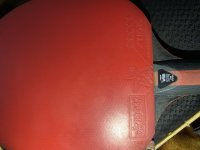Most of my experience is pre-water glue, the old VOC glue was easier to work with, I never needed multiple layers and didn't have to use a sponge because there was a brush included in the glue can.
Actually done and explained by someone working at a TT shop. Same process basically, but he glues 729 which is a more Chinese rubber so I figured this might be interesting to see.
So here's my takeaways after doing 2-3 bats with water glue:
- 2 layers is better than one. Sticks better, removes better. Also, apparently almost everyone uses at least 2 layers on both blade and rubber for new equipment nowadays.
- letting the layers dry makes for better contact (and less mess)
-
never use a sponge with semi-dried or completely dried glue in it. You get these annoying little sticky balls and they are a real pain to get off.
- containers with built-in applicators
suck because you will simply never get the glue completely rinsed out of it. Unless you plan on using all of the glue in one go (within half an hour) really just stay away from built-in applicators.
Yes, I think modern glues are a bit more annoying. But they're still not rocket science.










